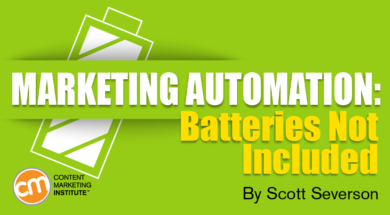Its results reveal lots of barriers to marketing-automation success, including those shown in this chart: This data reveals two truths that marketing-automation software sales reps will not bring up when they paint a picture of your idealized marketing future: Marketing automation is complex and requires an investment from your teams to translate existing processes into an established sales and marketing process before implementing. Companies that focus on the promise of marketing automation without thinking through the investment to develop content and what is needed to configure the software will set themselves up for failure. Lehnen suggests hiring a partner or agency to save money in the long run. Each of the major platforms has approved implementation partners that are experts in helping businesses implement and customize the tool. In my experience, hiring an implementation partner is money well spent to quickly get your marketing and sales teams up and running on the platform. Marketing leader – Marketing automation is all about results. You’ll need to either hire internal resources to produce this content or hire a content agency that specializes in developing content for marketing automation. Plan for content development According to the Ascend2 data, creating enough content is a major challenge in implementing marketing automation. You might start by thinking of the buyer’s journey as a funnel through which different types of content move your prospects along. Each type of content plays a role in moving potential customers through the buyer’s journey.

The sales pitch for investing in marketing-automation software is hard to resist. It goes something like this: “Our software will help you generate leads and then automatically nurture them along their journeys until they become your customers.” It sounds wonderful – a happy prospect skipping along a path paved by magical software.
Every business is looking for more effective ways to acquire new customers, and the promise of marketing automation presents a compelling solution. As a result, marketing automation is exploding as the tool of choice for marketers. As of this writing, the 10 most popular marketing-automation platforms are Infusionsoft, HubSpot, Eloqua, iContact, IBM Marketing Cloud, Marketo, Pardot, Teradata, ActOn, and SimplyCast. Over 83,000 companies are using these platforms alone.
Marketers need to remember, though, that all marketing-automation solutions – no matter how popular or compelling – present challenges. Challenges related to data quality and integration. Challenges related to creating enough content at a reasonable cost. Challenges related to poor marketing processes, lack of skilled staff, selecting metrics, and so on.
The research-based demand-generation company Ascend2 recently surveyed over 50,000 professionals to find the top challenges they face when it comes to marketing automation. Its results reveal lots of barriers to marketing-automation success, including those shown in this chart:

This data reveals two truths that marketing-automation software sales reps will not bring up when they paint a picture of your idealized marketing future:
- Marketing automation is complex and requires an investment from your teams to translate existing processes into an established sales and marketing process before implementing.
- Marketing automation requires a fire hose of content.
Yes, marketing automation can accelerate your sales pipeline – as long as you understand that it’s not a plug-and-play solution. It’s more of a batteries-not-included, assembly-required solution.
Companies that focus on the promise of marketing automation without thinking through the investment to develop content and what is needed to configure the software will set themselves up for failure.
What can you do to protect your investment and realize the true potential of marketing automation? Here’s what I recommend:
- Hire a pro.
- Assemble a team.
- Map your buyer’s journey.
- Plan for developing content.
1. Hire a pro
Unless you have a staff member with experience in configuring your specific marketing-automation software, self-implementation is usually a recipe for disaster. I learned this lesson the hard way. This is complex stuff that requires a deep knowledge of the marketing-automation software you chose, your sales process, the intricacies of your CRM (most commonly Salesforce), and your marketing strategy.
Eric Lehnen, Salesforce consultant at Redpath Consulting Group, put it this way in an email to me:
Most organizations will try the self-implementation route and quickly realize they are in over their heads. This is either from passing the task to a staff person who has limited knowledge, lack of marketing and sales alignment, or simply not enough resources to complete an implementation. This creates a half-baked result.
Lehnen suggests hiring a partner or agency to save money in the long run. For example, he says, trying to implement your own software could take you six months, whereas a partner might reduce that time to eight weeks. “This greatly accelerates your time to value, and helps you generate ROI faster,” he says.
Each of the major platforms has approved implementation partners that are experts in helping businesses implement and customize the tool. In my experience, hiring an implementation partner is money well spent to quickly get your…

COMMENTS